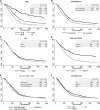The effects of clinical and sociodemographic factors on survival, resource use and lead times in patients with high-grade gliomas: a population-based register study
- PMID: 29846896
- PMCID: PMC6132971
- DOI: 10.1007/s11060-018-2899-0
The effects of clinical and sociodemographic factors on survival, resource use and lead times in patients with high-grade gliomas: a population-based register study
Abstract
Background: Previous studies indicate an effect of sociodemographic factors on risk for being diagnosed with, as well as on survival of cancer in general. Our primary aim was to analyse sociodemographic factors, resource use and lead times in health care after diagnosis with high grade malignant glioma (HGG) in a large population based cohort.
Methods: A register-based study using several unique high-coverage registries. All patients over the age of 18 diagnosed with HGG in the Swedish Stockholm-Gotland region between 2001 and 2013 (n = 1149) were included.
Results: In multivariable cox proportional hazard model of survival, older age, male sex and high tumour grade were associated with worse survival. No significant differences could be seen related to country of birth. A high disposable income was associated with better survival and fewer occasions of pre-diagnostic inpatient care. Older age and comorbidities were correlated with a significantly increased number of outpatient visits the year before HGG diagnosis. In addition, male sex, being born outside Sweden was associated to a higher number of outpatient visits the year after diagnosis in multivariable analysis. Leadtime from diagnosis (first suspicion on brain scan) to surgery showed that the oldest patients, patients with comorbidity and patients born outside Europe had to wait longer for surgery.
Conclusions: Sociodemographic factors like education, income and country of birth have impact on care processes both before and after the diagnosis HGG. This needs to be acknowledged in addition to important clinical factors like age, comorbidity and tumour grade, in order to accomplish more equal cancer care.
Keywords: Brain neoplasm; Comorbidity; Glioma; Health resources; Registries; Sociodemographic factors.
Conflict of interest statement
None to declare for Jenny Bergqvist and Roger Henriksson. Hanna Iderberg and Johan Mesterton are employed at Ivbar Institute, a research company specialized in health care governance and analysis of health care data. Johan Mesterton is a shareholder at Ivbar Institute.
Figures

References
MeSH terms
LinkOut - more resources
Full Text Sources
Other Literature Sources
Medical

